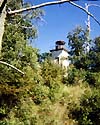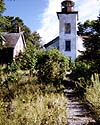|
Historical
Information

South Fox Island is located approximately seventeen miles off Cat's Head
Point, at the tip of the Leelanau Peninsula. The story of this Island
light began with Congress's
appropriation of $18,000 for the construction of a lighthouse there on
March 2, 1867.
Work on the light station began
immediately, with the construction of the Cream
City brick tower. With walls
thirteen inches in thickness, the square tower topped-out at forty-five
feet in height, and contained a forty-eight step cast iron spiral
staircase leading to the lantern room.
The lantern was outfitted with a
flashing red Fourth Order Fresnel
lens, and the station's first keeper Henry J. Roe
climbed the tower steps to exhibit the light for the first time on
November 1, 1867.
 Originally outfitted with a
steam-operated fog whistle, this system was later upgraded to a diaphone
fog signal. Operated by two steam boilers located in a twenty-two foot by
forty-foot wood-frame building, the walls of which were lined with iron sheathing
to
reflect the heat generated by the boilers. Originally outfitted with a
steam-operated fog whistle, this system was later upgraded to a diaphone
fog signal. Operated by two steam boilers located in a twenty-two foot by
forty-foot wood-frame building, the walls of which were lined with iron sheathing
to
reflect the heat generated by the boilers.
Plagued by drifting sands and snow,
which frequently piled so high as to interfere with access to the
station's buildings, Keeper Warner constructed a three hundred and
twenty foot long board fence, five feet high around the station in 1880.
With the addition of an assistant keeper to help with the duties
necessitated by operating a light station and fog signal on such a remote location, a
wood frame Assistant Keepers Quarters was also built near the tower
around 1898.
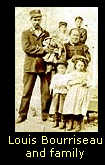 In 1892, keeper
Louis Bourisseau built
wooden walkways connecting the buildings and a few years later oversaw
the construction of an oil storage building. Safe fuel storage became a
necessity with the system-wide conversion from lard oil to kerosene as
the fuel used in all lamps, and the South Fox Island storage building
contained sufficient capacity to store 360 gallons of the volatile
liquid. In 1892, keeper
Louis Bourisseau built
wooden walkways connecting the buildings and a few years later oversaw
the construction of an oil storage building. Safe fuel storage became a
necessity with the system-wide conversion from lard oil to kerosene as
the fuel used in all lamps, and the South Fox Island storage building
contained sufficient capacity to store 360 gallons of the volatile
liquid.
In 1900 a steam launch replaced the
open sailing skiff as the station's official craft, and in 1910 the
assistant keeper's dwelling was replaced with a more permanent structure
of red brick. Around this time, the yellow brick tower was also given a
coat of white brick to help protect the bricks from the constant wind
and storm-driven rains.
With increasing population on South
Fox, a post office was built on the island in March 1906, and the
frequency of mail delivery to and from the island increased
significantly. However, the improvement was not long-lived, since the
office was closed in November 1911, and the light station returned to
monthly mal deliveries from the mail boat.
 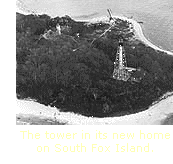 As a result of constant exposure to the
elements, the station was extremely difficult to maintain. In 1933, the
decision was made to replace the soft brick tower with a more permanent
modern structure. At this same time, shipments in and out
of the Darien Georgia area declined so significantly as to eliminate the
need for the lighthouse on Sapelo Island, which guarded Darien harbor.
With the decommissioning of the Sapelo Island lighthouse in 1933, the
twenty-eight year old cast iron skeletal tower was carefully
disassembled, each section numbered, and shipped to South Fox Island. As a result of constant exposure to the
elements, the station was extremely difficult to maintain. In 1933, the
decision was made to replace the soft brick tower with a more permanent
modern structure. At this same time, shipments in and out
of the Darien Georgia area declined so significantly as to eliminate the
need for the lighthouse on Sapelo Island, which guarded Darien harbor.
With the decommissioning of the Sapelo Island lighthouse in 1933, the
twenty-eight year old cast iron skeletal tower was carefully
disassembled, each section numbered, and shipped to South Fox Island.
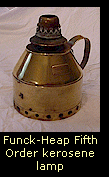 In 1934, a crew of civilian workers
from Northport arrived on the island to assist with the tower's
reconstruction. Digging holes and pouring nine foot deep concrete
foundations for the tower's legs, they also chipped the salt-weathered
paint from the structures components, and reassembled the tower's
sections in accordance with the previously applied identification
numbers. Finally, a diesel engine was installed to provide electricity
for the light and compressed air for the fog horn. In 1934, a crew of civilian workers
from Northport arrived on the island to assist with the tower's
reconstruction. Digging holes and pouring nine foot deep concrete
foundations for the tower's legs, they also chipped the salt-weathered
paint from the structures components, and reassembled the tower's
sections in accordance with the previously applied identification
numbers. Finally, a diesel engine was installed to provide electricity
for the light and compressed air for the fog horn.
At a point at which we have as yet been
unable to determine, the Coast Guard abandoned the station, radio
beacons, LORAN, Radar and GPS rendering it obsolete.
Today, approximately two-thirds of the island is owned by
David Victor Johnson, the developer of a number of upscale resort
developments. As of this writing, the future ownership of the remainder
of the island is a matter of considerable controversy. We only hope that
through it all some arrangement can be made to ensure the long-term
survival of these two historic lighthouses structures, which are
currently deteriorating rapidly from a lack of much needed maintenance.
Keepers of this
Light

Click Here to see a complete listing of
all South Fox Island Light keepers compiled by Phyllis L. Tag of Great
Lakes Lighthouse Research.
Seeing this
Light

We have not yet visited South Fox Island, but will continue to update
this page until we get the opportunity, and will add photography
thereafter. A big thanks
to John Bourisseau, the great-grandson of Louis Bourisseau for sharing
his photographs with us.
Finding this
Light

 As of this writing,
we are not aware of any public tour boats offering trips to South Fox,
and thus the island can only be reached by private vessels suitable for
safe offshore cruising. As of this writing,
we are not aware of any public tour boats offering trips to South Fox,
and thus the island can only be reached by private vessels suitable for
safe offshore cruising.
Reference Sources

Inventory
of Historic Light Stations, National Parks Service, 1994
History of Leelanau Township, Leelanau Township Historical
Writers, 1982
The Fox Islands, Kathleen Craker Firestone, 1996, pp 76-95
USCG Historians office, Photographic archives
Photographs courtesy of John Bourisseau.
12/4/00 email from Tom Tag re Fresnel Order installed at the station.
The South Fox Island Project, website
Sapelo Island Georgia, website
Keeper listings for this light appear courtesy of Great
Lakes Lighthouse Research
|

